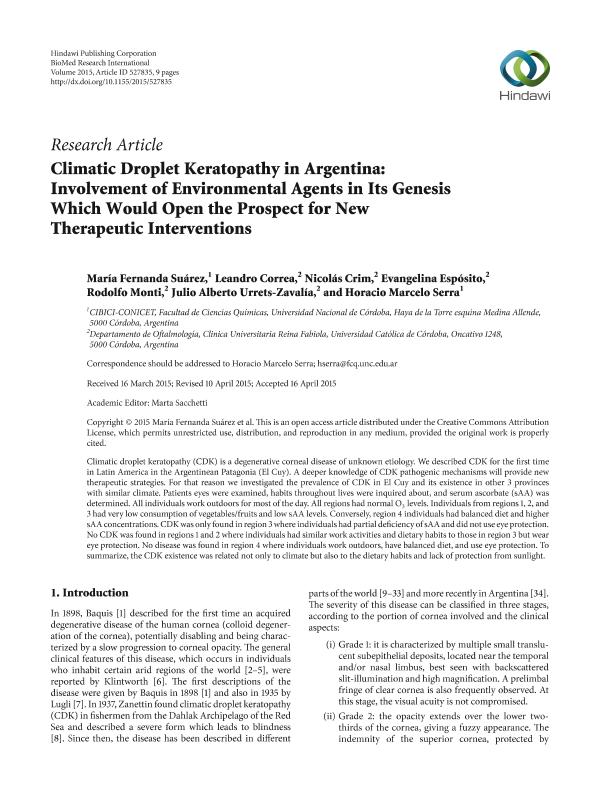Artículo
Climatic droplet keratopathy in Argentina: involvement of environmental agents in its genesis which would open the prospect for new therapeutic interventions
Suarez, Maria Fernanda ; Correa, Leandro Javier; Crim, Nicolás; Esposito, Evangelina; Monti, Jose Rodolfo; Urrets Zavalía, Julio Alberto; Serra, Horacio Marcelo
; Correa, Leandro Javier; Crim, Nicolás; Esposito, Evangelina; Monti, Jose Rodolfo; Urrets Zavalía, Julio Alberto; Serra, Horacio Marcelo
 ; Correa, Leandro Javier; Crim, Nicolás; Esposito, Evangelina; Monti, Jose Rodolfo; Urrets Zavalía, Julio Alberto; Serra, Horacio Marcelo
; Correa, Leandro Javier; Crim, Nicolás; Esposito, Evangelina; Monti, Jose Rodolfo; Urrets Zavalía, Julio Alberto; Serra, Horacio Marcelo
Fecha de publicación:
09/2015
Editorial:
HINDAWI
Revista:
BioMed Research International
ISSN:
2314-6133
e-ISSN:
2314-6141
Idioma:
Inglés
Tipo de recurso:
Artículo publicado
Clasificación temática:
Resumen
Climatic droplet keratopathy (CDK) is a degenerative corneal disease of unknown etiology. We described CDK for the rst time in Latin America in the Argentinean Patagonia (El Cuy). A deeper knowledge of CDK pathogenic mechanisms will provide new therapeutic strategies. For that reason we investigated the prevalence of CDK in El Cuy and its existence in other 3 provinces with similar climate. Patients eyes were examined, habits throughout lives were inquired about, and serum ascorbate (sAA) was determined. All individuals work outdoors for most of the day. All regions had normal O3 levels. Individuals from regions 1, 2, and 3 had very low consumption of vegetables/fruits and low sAA levels. Conversely, region 4 individuals had balanced diet and higher sAA concentrations. CDK was only found in region 3 where individuals had partial de ciency of sAA and did not use eye protection. No CDK was found in regions 1 and 2 where individuals had similar work activities and dietary habits to those in region 3 but wear eye protection. No disease was found in region 4 where individuals work outdoors, have balanced diet, and use eye protection. To summarize, the CDK existence was related not only to climate but also to the dietary habits and lack of protection from sunlight.
Palabras clave:
Climatic Droplet Keratopathy
,
Ascorbic Acid
,
Argentina
,
Uv-B Radiation
Archivos asociados
Licencia
Identificadores
Colecciones
Articulos(CIBICI)
Articulos de CENTRO DE INV.EN BIOQUI.CLINICA E INMUNOLOGIA
Articulos de CENTRO DE INV.EN BIOQUI.CLINICA E INMUNOLOGIA
Citación
Suarez, Maria Fernanda; Correa, Leandro Javier; Crim, Nicolás; Esposito, Evangelina; Monti, Jose Rodolfo; et al.; Climatic droplet keratopathy in Argentina: involvement of environmental agents in its genesis which would open the prospect for new therapeutic interventions; HINDAWI; BioMed Research International; 2015; 9-2015
Compartir
Altmétricas



